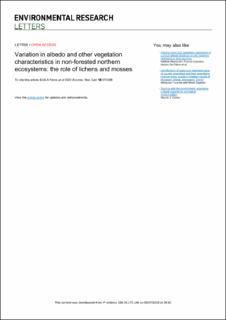Variation in albedo and other vegetation characteristics in non-forested northern ecosystems: the role of lichens and mosses
Finne, Eirik Aasmo; Bjerke, Jarle W.; Erlandsson, Rasmus; Tømmervik, Hans; Stordal, Frode; Tallaksen, Lena M.
Peer reviewed, Journal article
Published version

Åpne
Permanent lenke
https://hdl.handle.net/11250/3076567Utgivelsesdato
2023Metadata
Vis full innførselSamlinger
- Publikasjoner fra CRIStin - NINA [2364]
- Scientific publications [1392]
Originalversjon
10.1088/1748-9326/ace06dSammendrag
Vegetation has a profound impact on climate through complex interactions and feedback loops, where especially regulation of albedo, the ratio of reflected to incoming solar radiation, is important at high latitudes. How vegetation albedo varies along environmental gradients in tundra ecosystems is still not well understood, particularly for ecosystems dominated by nonvascular vegetation. We studied broadband shortwave albedo of open boreal, arctic, and alpine ecosystems over a 2000 km long latitudinal gradient (60◦ N–79◦ N) and contrasted this against species composition, vegetation greenness (normalised difference vegetation index—NDVI), momentary ecosystem CO2 fluxes and reindeer (Rangifer tarandus) grazing pressure. High cover of pale terricolous fruticose lichens was the single most important predictor for vegetation albedo, which had a maximum value of 0.389 under clear sky conditions and solar zenith angle 60◦. To our knowledge, this is the highest broadband albedo recorded for a vegetated surface. NDVI was negatively correlated to lichen biomass (rs = −0.56), and albedo (rs = −0.19). Gross primary production and ecosystem respiration varied considerably less between plots and vegetation types than albedo. While it is well-known that Rangifer affects climate-relevant aboveground biomass, we here show that its regulation of surface albedo in northern ecosystems may also be of high importance for land-atmosphere interactions. The data presented here thus advocate for an increased understanding of the important and complex role of herbivores and lichen cover in climate-vegetation interactions.
